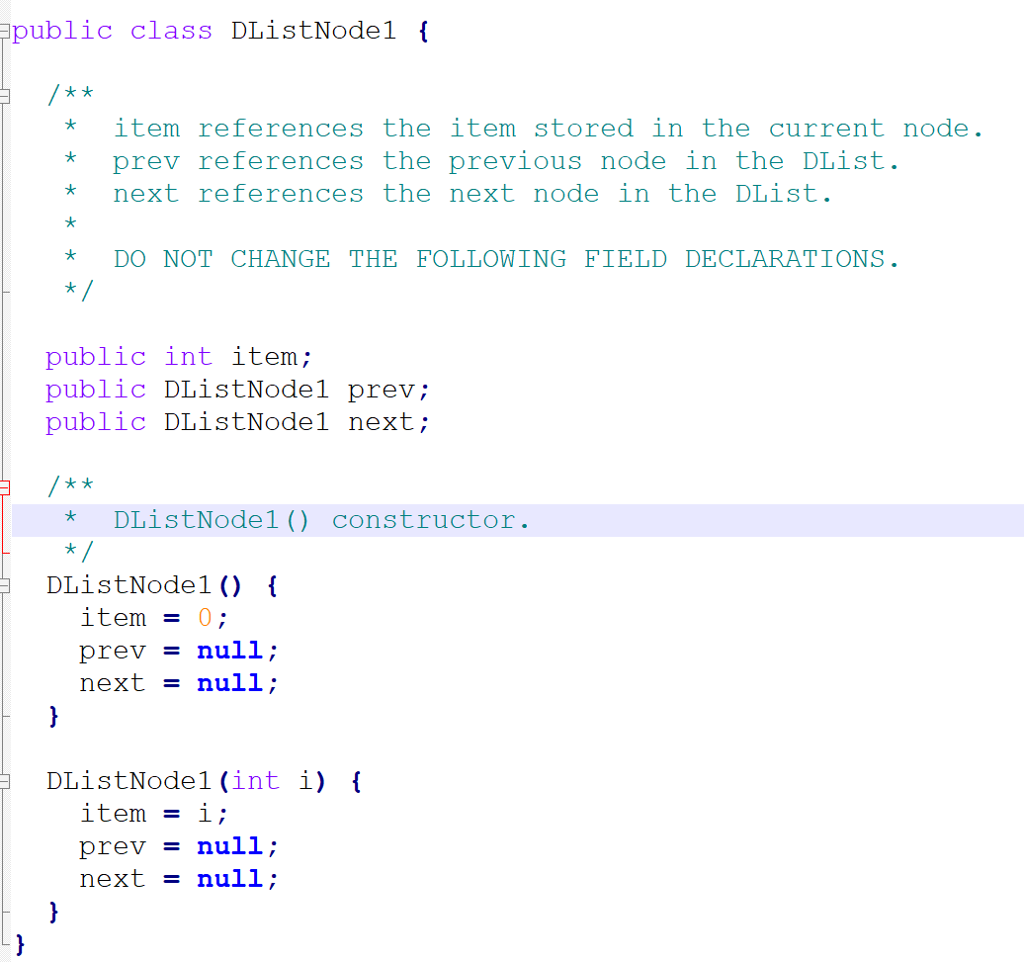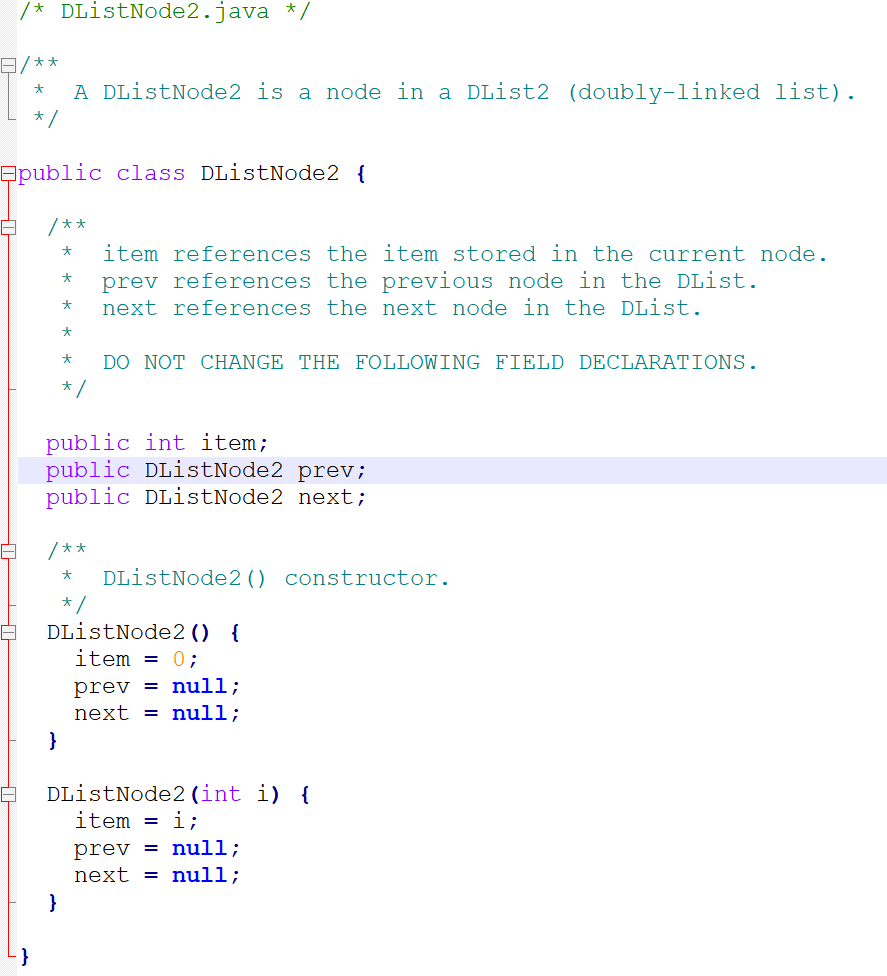Question
Please not copy and paste and try to run both of the codes after programming. The code only need 4 of the methods. Thank you.
Please not copy and paste and try to run both of the codes after programming. The code only need 4 of the methods. Thank you.


/* DList1.java */
/** * A DList1 is a mutable doubly-linked list. (No sentinel, not * circularly linked.) */
public class DList1 {
/** * head references the first node. * tail references the last node. * * DO NOT CHANGE THE FOLLOWING FIELD DECLARATIONS. */
protected DListNode1 head; protected DListNode1 tail; protected long size;
/* DList1 invariants: * 1) head.prev == null. * 2) tail.next == null. * 3) For any DListNode1 x in a DList, if x.next == y and x.next != null, * then y.prev == x. * 4) For any DListNode1 x in a DList, if x.prev == y and x.prev != null, * then y.next == x. * 5) The tail can be accessed from the head by a sequence of "next" * references. * 6) size is the number of DListNode1s that can be accessed from the * head by a sequence of "next" references. */
/** * DList1() constructor for an empty DList1. */ public DList1() { head = null; tail = null; size = 0; }
/** * DList1() constructor for a one-node DList1. */ public DList1(int a) { head = new DListNode1(); tail = head; head.item = a; size = 1; }
/** * DList1() constructor for a two-node DList1. */ public DList1(int a, int b) { head = new DListNode1(); head.item = a; tail = new DListNode1(); tail.item = b; head.next = tail; tail.prev = head; size = 2; }
/** * insertFront() inserts an item at the front of a DList1. */ public void insertFront(int i) { // Your solution here. }
/** * removeFront() removes the first item (and node) from a DList1. If the * list is empty, do nothing. */ public void removeFront() { // Your solution here. }
/** * toString() returns a String representation of this DList. * * DO NOT CHANGE THIS METHOD. * * @return a String representation of this DList. */ public String toString() { String result = "[ "; DListNode1 current = head; while (current != null) { result = result + current.item + " "; current = current.next; } return result + "]"; }
public static void main(String[] args) { // DO NOT CHANGE THE FOLLOWING CODE.
DList1 l = new DList1(); System.out.println("### TESTING insertFront ### Empty list is " + l);
l.insertFront(9); System.out.println(" Inserting 9 at front. List with 9 is " + l); if (l.head == null) { System.out.println("head is null."); } else { if (l.head.item != 9) { System.out.println("head.item is wrong."); } if (l.head.prev != null) { System.out.println("head.prev is wrong."); } } if (l.tail == null) { System.out.println("tail is null."); } else { if (l.tail.item != 9) { System.out.println("tail.item is wrong."); } if (l.tail.next != null) { System.out.println("tail.next is wrong."); } } if (l.size != 1) { System.out.println("size is wrong."); }
l.insertFront(8); System.out.println(" Inserting 8 at front. List with 8 and 9 is " + l); if (l.head == null) { System.out.println("head is null."); } else { if (l.head.item != 8) { System.out.println("head.item is wrong."); } if (l.head.prev != null) { System.out.println("head.prev is wrong."); } if (l.head.next != l.tail) { System.out.println("head.next is wrong."); } } if (l.tail == null) { System.out.println("tail is null."); } else { if (l.tail.item != 9) { System.out.println("tail.item is wrong."); } if (l.tail.next != null) { System.out.println("tail.next is wrong."); } if (l.tail.prev != l.head) { System.out.println("tail.prev is wrong."); } } if (l.size != 2) { System.out.println("size is wrong."); }
l = new DList1(1, 2); System.out.println(" ### TESTING removeFront ### List with 1 and 2 is " + l);
l.removeFront(); System.out.println(" Removing front node. List with 2 is " + l); if (l.head.item != 2) { System.out.println("head.item is wrong."); } if (l.head.prev != null) { System.out.println("head.prev is wrong."); } if (l.tail.item != 2) { System.out.println("tail.item is wrong."); } if (l.tail.next != null) { System.out.println("tail.next is wrong."); } if (l.size != 1) { System.out.println("size is wrong."); }
l.removeFront(); System.out.println(" Removing front node. Empty list is " + l); if (l.head != null) { System.out.println("head is wrong."); } if (l.tail != null) { System.out.println("tail is wrong."); } if (l.size != 0) { System.out.println("size is wrong."); }
l.removeFront(); System.out.println(" Removing front node. Empty list is " + l); if (l.head != null) { System.out.println("head is wrong."); } if (l.tail != null) { System.out.println("tail is wrong."); } if (l.size != 0) { System.out.println("size is wrong."); } }
}

/* DList2.java */
/** * A DList2 is a mutable doubly-linked list. Its implementation is * circularly-linked and employs a sentinel (dummy) node at the head * of the list. */
public class DList2 {
/** * head references the sentinel node. * * DO NOT CHANGE THE FOLLOWING FIELD DECLARATIONS. */
protected DListNode2 head; protected long size;
/* DList2 invariants: * 1) head != null. * 2) For any DListNode2 x in a DList2, x.next != null. * 3) For any DListNode2 x in a DList2, x.prev != null. * 4) For any DListNode2 x in a DList2, if x.next == y, then y.prev == x. * 5) For any DListNode2 x in a DList2, if x.prev == y, then y.next == x. * 6) size is the number of DListNode2s, NOT COUNTING the sentinel * (denoted by "head"), that can be accessed from the sentinel by * a sequence of "next" references. */
/** * DList2() constructor for an empty DList2. */ public DList2() { head = new DListNode2(); head.item = Integer.MIN_VALUE; head.next = head; head.prev = head; size = 0; }
/** * DList2() constructor for a one-node DList2. */ public DList2(int a) { head = new DListNode2(); head.item = Integer.MIN_VALUE; head.next = new DListNode2(); head.next.item = a; head.prev = head.next; head.next.prev = head; head.prev.next = head; size = 1; }
/** * DList2() constructor for a two-node DList2. */ public DList2(int a, int b) { head = new DListNode2(); head.item = Integer.MIN_VALUE; head.next = new DListNode2(); head.next.item = a; head.prev = new DListNode2(); head.prev.item = b; head.next.prev = head; head.next.next = head.prev; head.prev.next = head; head.prev.prev = head.next; size = 2; }
/** * insertFront() inserts an item at the front of a DList2. */ public void insertFront(int i) { // Your solution here. }
/** * removeFront() removes the first item (and first non-sentinel node) from * a DList2. If the list is empty, do nothing. */ public void removeFront() { // Your solution here. }
/** * toString() returns a String representation of this DList. * * DO NOT CHANGE THIS METHOD. * * @return a String representation of this DList. */ public String toString() { String result = "[ "; DListNode2 current = head.next; while (current != head) { result = result + current.item + " "; current = current.next; } return result + "]"; }
public static void main(String[] args) { // DO NOT CHANGE THE FOLLOWING CODE.
DList2 l = new DList2(); System.out.println("### TESTING insertFront ### Empty list is " + l);
l.insertFront(9); System.out.println(" Inserting 9 at front. List with 9 is " + l); if (l.head.next.item != 9) { System.out.println("head.next.item is wrong."); } if (l.head.next.prev != l.head) { System.out.println("head.next.prev is wrong."); } if (l.head.prev.item != 9) { System.out.println("head.prev.item is wrong."); } if (l.head.prev.next != l.head) { System.out.println("head.prev.next is wrong."); } if (l.size != 1) { System.out.println("size is wrong."); }
l.insertFront(8); System.out.println(" Inserting 8 at front. List with 8 and 9 is " + l); if (l.head.next.item != 8) { System.out.println("head.next.item is wrong."); } if (l.head.next.prev != l.head) { System.out.println("head.next.prev is wrong."); } if (l.head.prev.item != 9) { System.out.println("head.prev.item is wrong."); } if (l.head.prev.next != l.head) { System.out.println("head.prev.next is wrong."); } if (l.head.next.next != l.head.prev) { System.out.println("l.head.next.next != l.head.prev."); } if (l.head.prev.prev != l.head.next) { System.out.println("l.head.prev.prev != l.head.next."); } if (l.size != 2) { System.out.println("size is wrong."); }
l = new DList2(1, 2); System.out.println(" ### TESTING removeFront ### List with 1 and 2 is " + l);
l.removeFront(); System.out.println(" List with 2 is " + l); if (l.head.next.item != 2) { System.out.println("head.next.item is wrong."); } if (l.head.next.prev != l.head) { System.out.println("head.next.prev is wrong."); } if (l.head.prev.item != 2) { System.out.println("head.prev.item is wrong."); } if (l.head.prev.next != l.head) { System.out.println("head.prev.next is wrong."); } if (l.size != 1) { System.out.println("size is wrong."); }
l.removeFront(); System.out.println(" Empty list is " + l); if (l.head.next != l.head) { System.out.println("head.next is wrong."); } if (l.head.prev != l.head) { System.out.println("head.prev is wrong."); } if (l.size != 0) { System.out.println("size is wrong."); }
l.removeFront(); System.out.println(" Empty list is " + l); if (l.head.next != l.head) { System.out.println("head.next is wrong."); } if (l.head.prev != l.head) { System.out.println("head.prev is wrong."); } if (l.size != 0) { System.out.println("size is wrong."); } }
}
two different types of doubly-linked list. The DListl class does not use a sentinel, whereas the DLst2 class does. The DL1stI class is not circularly linked, but the DLst2 class is (through the sentinel). Compile DListl.java and DList2.java (using "javac -g DListl.java DList2.java".) Your task is to implement two insertFront ) and two removeFront ) methods--one of each for each list class. insertFront() and removeFront () insert or remove an item at the beginning of a list. Make sure your implementations work for empty lists, one-node lists, and larger lists. The main() methods of DList1 and DList2 nclude test code, which you can run with "java DListl" and "java DList2". Part I insertFront in DList1 Write a method called DList1.insertFront () that inserts an int at the front of "this" DList1. Part II removeFront in DListl Write a method called DList1.removeFront node) from "this" DListl that removes the first item (and Part III: insertFront in DLst2 Write a method called DList2.insertFront that inserts an int at the front of "this" DList2. Your code should NOT use any "if" statements or conditionals. Part IV: removeFront in DList2 Write a method called DList2.removeFront that removes the first item (and non-sentinel node) from "this" DList2. Your code should not require separate branches for the one-node case and the more-than-one-node case. (You will need one "if", to handle the zero-node case.) Check-off Run the DListl and DList2 test code. DListl.insertFront () DList 1 . remove Front ( ) . DList2.insertFront ()Step by Step Solution
There are 3 Steps involved in it
Step: 1

Get Instant Access to Expert-Tailored Solutions
See step-by-step solutions with expert insights and AI powered tools for academic success
Step: 2

Step: 3

Ace Your Homework with AI
Get the answers you need in no time with our AI-driven, step-by-step assistance
Get Started


